Atmospheric CO2 Concentrations in Caves Protected as Nature Reserves and Related Gas Hazard
Abstract
1. Introduction
2. Study Area: Topography, Climate, Geology, and Geomorphology
3. Materials and Methods
4. Results
4.1. Carburangeli Cave
4.2. Santa Ninfa Cave
4.3. Sant’Angelo Muxaro
5. Discussion
5.1. General Considerations about CO2 Hazard Evaluation in Caves
5.2. Spot Data
5.3. Near-Real-Time Data and CO2 Impact by/to Visitors
6. Conclusions
Author Contributions
Funding
Informed Consent Statement
Data Availability Statement
Acknowledgments
Conflicts of Interest
References
- Environmental Protection Agency. Available online: https://www.epa.gov/sites/default/files/2015-06/documents/co2appendixb.pdf (accessed on 11 September 2022).
- Global Monitoring Laboratory. Available online: https://gml.noaa.gov/ccgg/trends/data.html (accessed on 11 September 2022).
- EH40/2005. Workplace Exposure Limits. Available online: https://books.hse.gov.uk/ (accessed on 9 September 2022).
- L’Anidride Carbonica. Aspetti di Sicurezza. Available online: https://assogastecnici.federchimica.it/docs/default-source/ATTI-CONVEGNI/2016_05_24-seminario-co2/04_safety-de-lorenzi-ppt.pdf?sfvrsn=a15ae528_2 (accessed on 9 September 2022).
- Human Health Risk Assessment of CO2: Survivors of Acute High-Level Exposure and Populations Sensitive to Prolonged Low-Level Exposure. Available online: https://citeseerx.ist.psu.edu/viewdoc/download?doi=10.1.1.521.9527&rep=rep1&type=pdf (accessed on 11 September 2022).
- Surić, M.; Lončarić, R.; Kulišić, M.; Sršen, L. Spatio-temporal variations of cave-air CO2 concentrations in two Croatian show caves: Natural vs. anthropogenic controls. Geol. Croat. 2021, 74, 273–286. [Google Scholar] [CrossRef]
- Viveiros, F.; Ferreira, T.; Silva, C.; Gaspar, J.L. Meteorological factors controlling soil gases and indoor CO2 concentration: A permanent risk in degassing areas. Sci. Total Environ. 2009, 407, 1362–1372. [Google Scholar] [CrossRef] [PubMed]
- Wrona, P.; Ro’zan´ski, Z.; Pach, G.; Suponik, T.; Popczyk, M. Closed coal mine shaft as a source of carbon dioxide emissions. Environ. Earth Sci. 2016, 75, 1139. [Google Scholar] [CrossRef][Green Version]
- Prelovšek, M.; Šebela, S.; Turk, J. Carbon dioxide in Postojna Cave (Slovenia): Spatial distribution, seasonal dynamics and evaluation of plausible sources and sinks. Environ. Earth Sci. 2018, 289, 289. [Google Scholar] [CrossRef]
- Foul Air in Limestone Caves and Its Effects on Cavers. Available online: https://wasg.org.au/index.php/2015-09-05-08-07-15/2016-06-09-12-53-47/foul-air (accessed on 12 September 2022).
- Baker, A.; Genty, D. Environmental pressures on conserving cave speleothems: Effects of changing surface land use and increased cave tourism. J. Environ. Manag. 1998, 53, 165–175. [Google Scholar] [CrossRef]
- Casamento, G. Introduzione e ringraziamenti. In Le Riserve Naturali Siciliane Gestite da Legambiente: Un Contributo alla Conoscenza ed alla Tutela; Casamento, G., Ed.; Società Siciliana di Scienze Naturali: Palermo, Italy, 2001; Volume 25, pp. 3–4. [Google Scholar]
- Di Maggio, C.; Madonia, G.; Parise, M.; Vattano, M. Karst of Sicily and its conservation. J. Cave Karst Stud. 2012, 74, 157–172. [Google Scholar] [CrossRef]
- Madonia, P. Monitoring Climatic Changes and Carbon Cycle in Canyons and Caves: The C6 Project. J. Environ. Sci. Eng. 2011, 5, 281–288. [Google Scholar]
- Madonia, P.; Bellanca, A.; Di Pietro, R.; Mirabello, L. The role of near-surface cavities in the carbon dioxide cycle of karst areas: Evidence from the Carburangeli Cave Natural Reserve (Italy). Environ. Earth Sci. 2012, 67, 2423–2439. [Google Scholar] [CrossRef]
- Geiger, R. Köppen-Geiger/Klima der Erde; Überarbeitete Neuausgabe von Geiger, R., Ed.; Klett-Perthes: Gotha, Germany, 1961; Wandkarte 1:16 Mill. [Google Scholar]
- SIAS. Climatologia della Sicilia; Servizio Informativo Agrometeorologico Siciliano (SIAS), Assessorato Agricoltura e Foreste, Regione Siciliana: Palermo, Italy, 2002; pp. 1–642. [Google Scholar]
- Di Maggio, C.; Madonia, G.; Vattano, M.; Agnesi, V.; Monteleone, S. Geomorphological evolution of Western Sicily, Italy. Geol. Carp. 2017, 68, 80–93. [Google Scholar] [CrossRef]
- Madonia, P. Considerazioni preliminari sul monitoraggio di temperatura, umidità e concentrazione di CO2 nell’atmosfera ipogea della Grotta di Santa Ninfa. In Le Riserve Naturali Siciliane Gestite da Legambiente: Un Contributo alla Conoscenza ed alla Tutela; Casamento, G., Ed.; Società Siciliana di Scienze Naturali: Palermo, Italy, 2001; Volume 25, pp. 255–269. [Google Scholar]
- Ek, C.; Gewelt, M. Carbon dioxide in cave atmospheres. New results in Belgium and comparison with some other Countries. Earth Surf. Process. Landf. 1985, 10, 174–187. [Google Scholar] [CrossRef]
- Whitaker, T.; Hones, D.; Baldini, J.U.L.; Baker, A.J. A high-resolution spatial of cave air carbon dioxide concentrations in Scoska Cave (North Yorkshire, UK): Implications for calcite deposition and re-dissolution. Cave Karst Sci. 2009, 36, 3. [Google Scholar]
- Linan, C.; Vadillo, I.; Carrasco, F. Carbon dioxide in air within the Narja Cave (Malaga, Andalusia, Spain). Int. J. Speleol. 2008, 37, 99–106. [Google Scholar] [CrossRef]
- Cowan, B.D.; Osborne, M.C.; Banner, J.L. Temporal variability of cave-air CO2 in Central Texas. J. Cave Karst Stud. 2013, 75, 38–50. [Google Scholar] [CrossRef]
- Faimon, J.; Stelcl, J.; Sas, D. Anthropogenic CO2-flux into cave atmosphre and its environmental impact: A case study in the Cisarska Cave (Moravian Karst, Czech Republic). Sci. Total Environ. 2006, 369, 231–245. [Google Scholar] [CrossRef]
- Faimon, J.; Licbinska, M. Carbon dioxide in the soils and adjacent caves of the Moravian Karst. Acta Carsol. 2010, 39, 463–475. [Google Scholar] [CrossRef]
- Faimon, J.; Troppova, D.; Baldik, V.; Novotny, R. Air circulation and its impact on microclimatic variables in the Cisarska Cave (Moravian Karst, Czech Republic). Int. J. Climatol. 2012, 32, 599–623. [Google Scholar] [CrossRef]
- Maleki, A.; Soltani, P.K. Touristis and their role in microclimatic changes inside the caves case study: Ali Sadr Cave (Hamedan, Iran). J. Biodiv. Environ. Sci. 2015, 6, 535–541. [Google Scholar]
- Faiman, J.; Licbinska, M.; Zajicek, P. Relationship between carbon dioxide in Balcarka Cave and adjacent soils in the Moravian Karst region of the Czech Republic. Int. J. Speleol. 2012, 41, 17–28. [Google Scholar] [CrossRef]
- Milanolo, S.; Gabrovsek, F. Analysis of Carbon Dioxide Variations in the Atmosphere of Srednja Bijambarska Cave, Bosnia and Herzegovina. Bound. Layer Meteorol. 2009, 131, 479–493. [Google Scholar] [CrossRef]
- Fernandez-Cortes, A.; Cuezva, S.; Sanchez-Moral, S.; Canaveras, J.C.; Porca, E.; Jurado, V.; Martin-Sanchez, P.M.; Saiz-Jimenez, C. Detection of human-induced environmental disturbances in a show cave. Environ. Sci. Pollut. Res. 2011, 18, 1037–1045. [Google Scholar] [CrossRef]
- Howarth, F.G.; Stone, F.D. Elevated Carbon Dioxide Levels in Bayliss Cave, Australia: Implications for the Evolution of Obligate Cave Species. Pac. Sci. 1990, 44, 207–218. [Google Scholar]
- Baldini, J.U.L.; Baldini, L.M.; McDerott, F.; Clipson, N. Carbon Dioxide Sources, Sinks, And Spatial Variability in Shallow Temperate Zone Caves: Evidence from Ballynamintra Cave, Ireland. J. Cave Karst Stud. 2006, 68, 4–11. [Google Scholar]
- Azuma, K.; Kagi, N.; Yanagi, U.; Osawa, H. Effects of low-level inhalation exposure to carbon dioxide in indoor environments: A short review on human health and psychomotor performance. Environ. Int. 2019, 121, 51–56. [Google Scholar] [CrossRef] [PubMed]
- Madonia, P.; Madonia, G. The Santa Ninfa Cave (Belice Valley): Hydrogeochemical features and relationships with neotectonics. Ann. Geophys. 2020, 63, SE103. [Google Scholar] [CrossRef]
- Censi, V.; Zuddas, P.; Sposito, F.; Cangemi, M.; Inguaggiato, C.; Piazzese, D. Boron and lithium behaviour in river waters under semiarid climatic conditions. Chemosphere 2022, 306, 135509. [Google Scholar] [CrossRef]
- Tsega, E.G.; Katiyar, K.; Gupta, P. Breathing Patterns of Healthy Human Response to Different Levels of Physical Activity. J. Biomed. Eng. Technol. 2019, 7, 1–4. [Google Scholar] [CrossRef]
- What Is Carbon Dioxide. Available online: https://www.co2meter.com/blogs/news/10709101-what-is-carbon-dioxide (accessed on 12 September 2022).
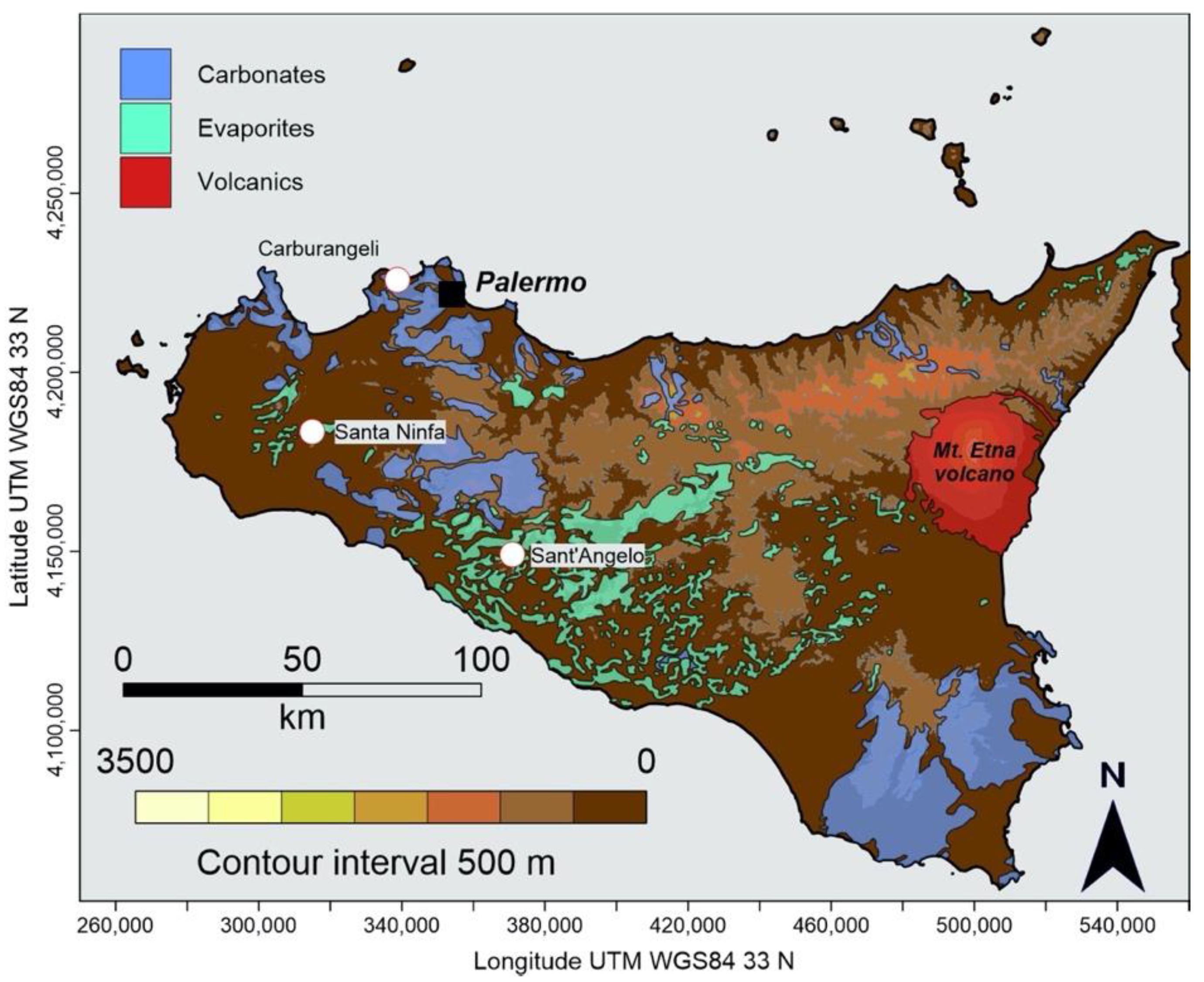
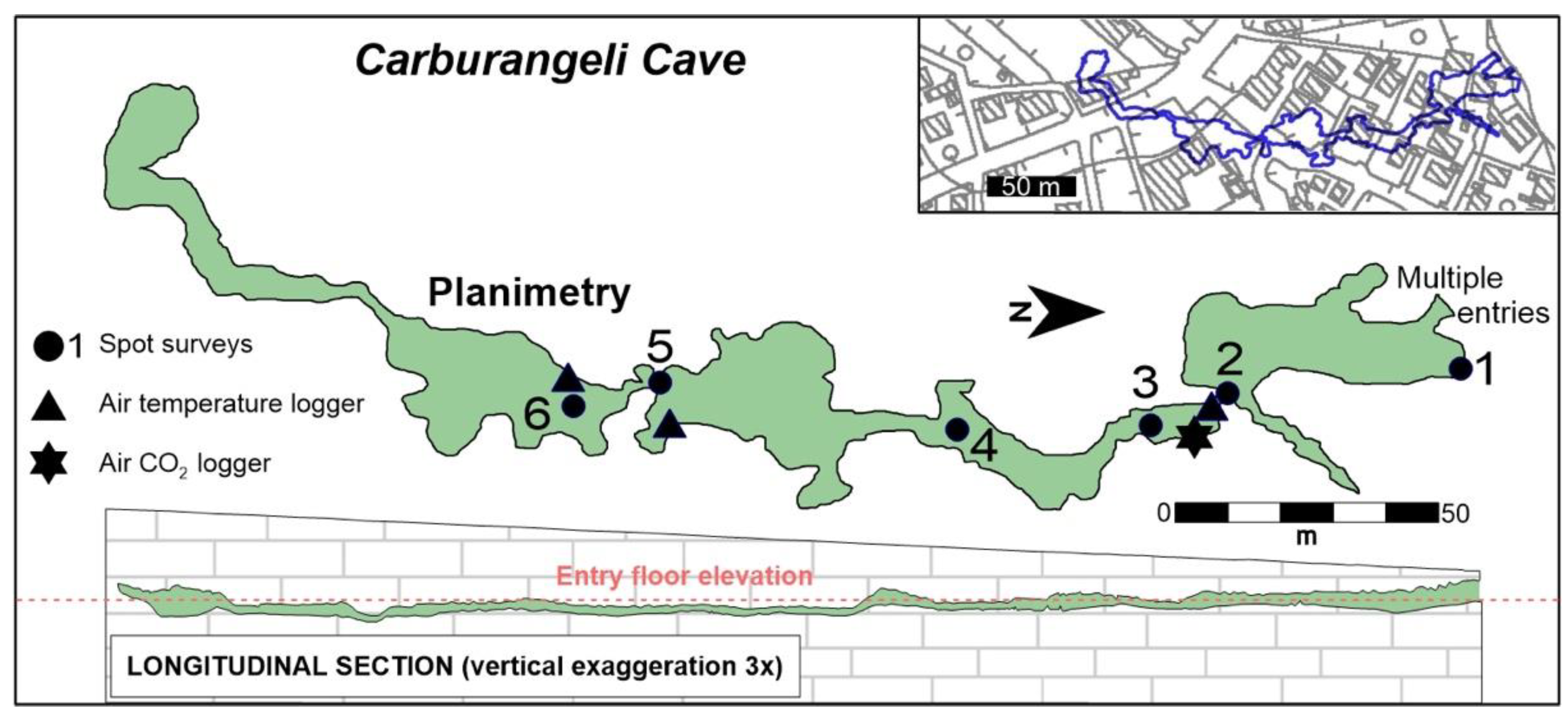
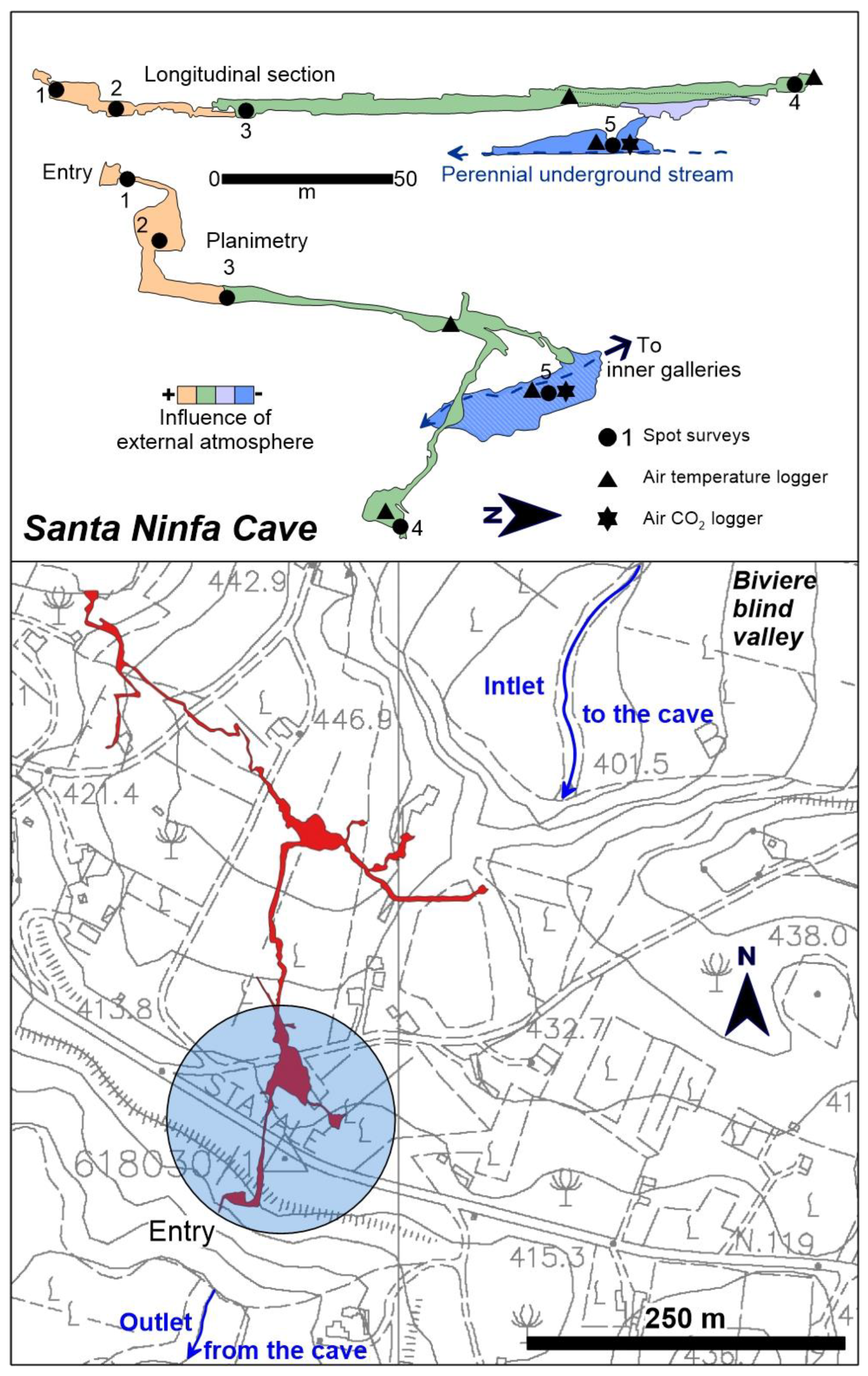
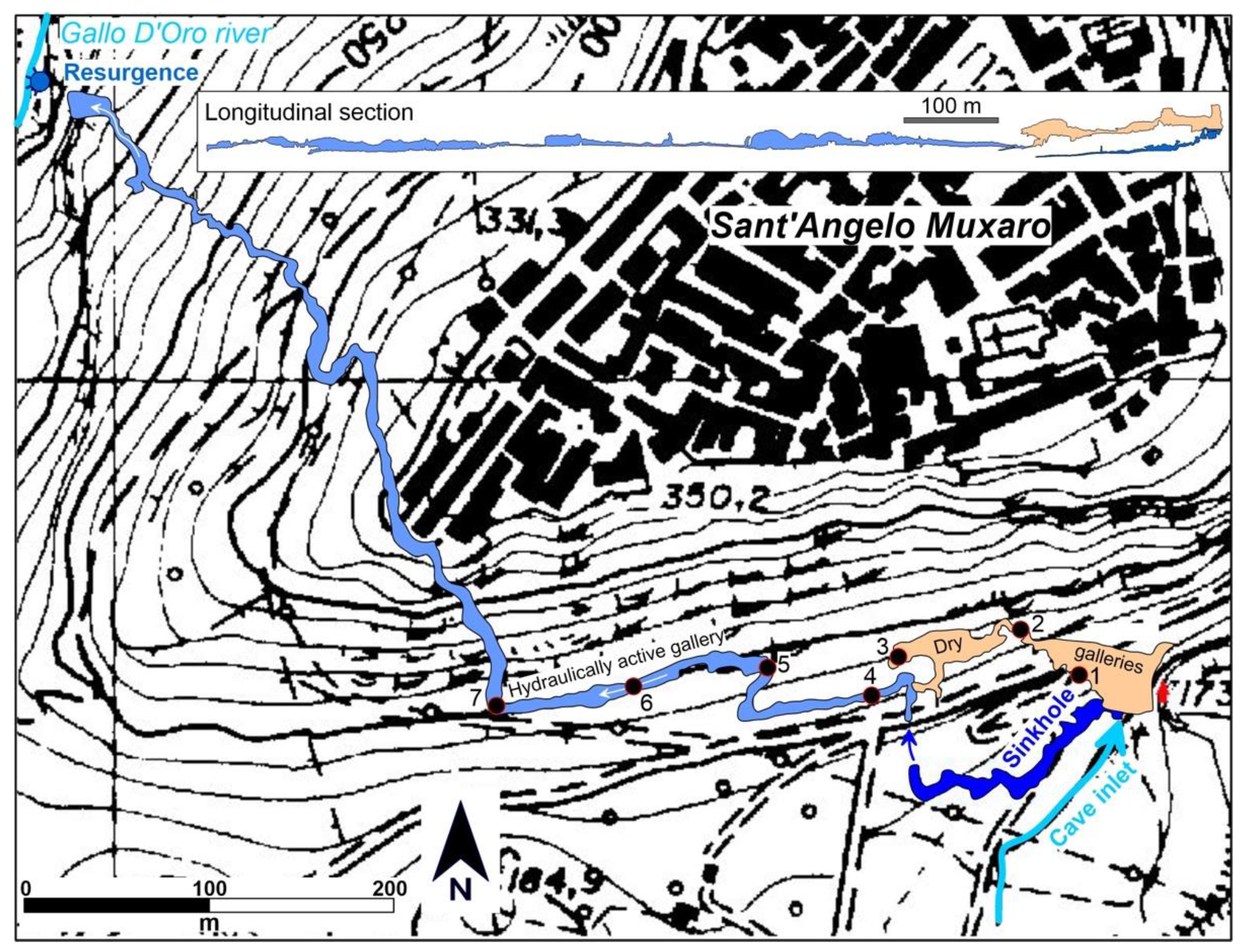
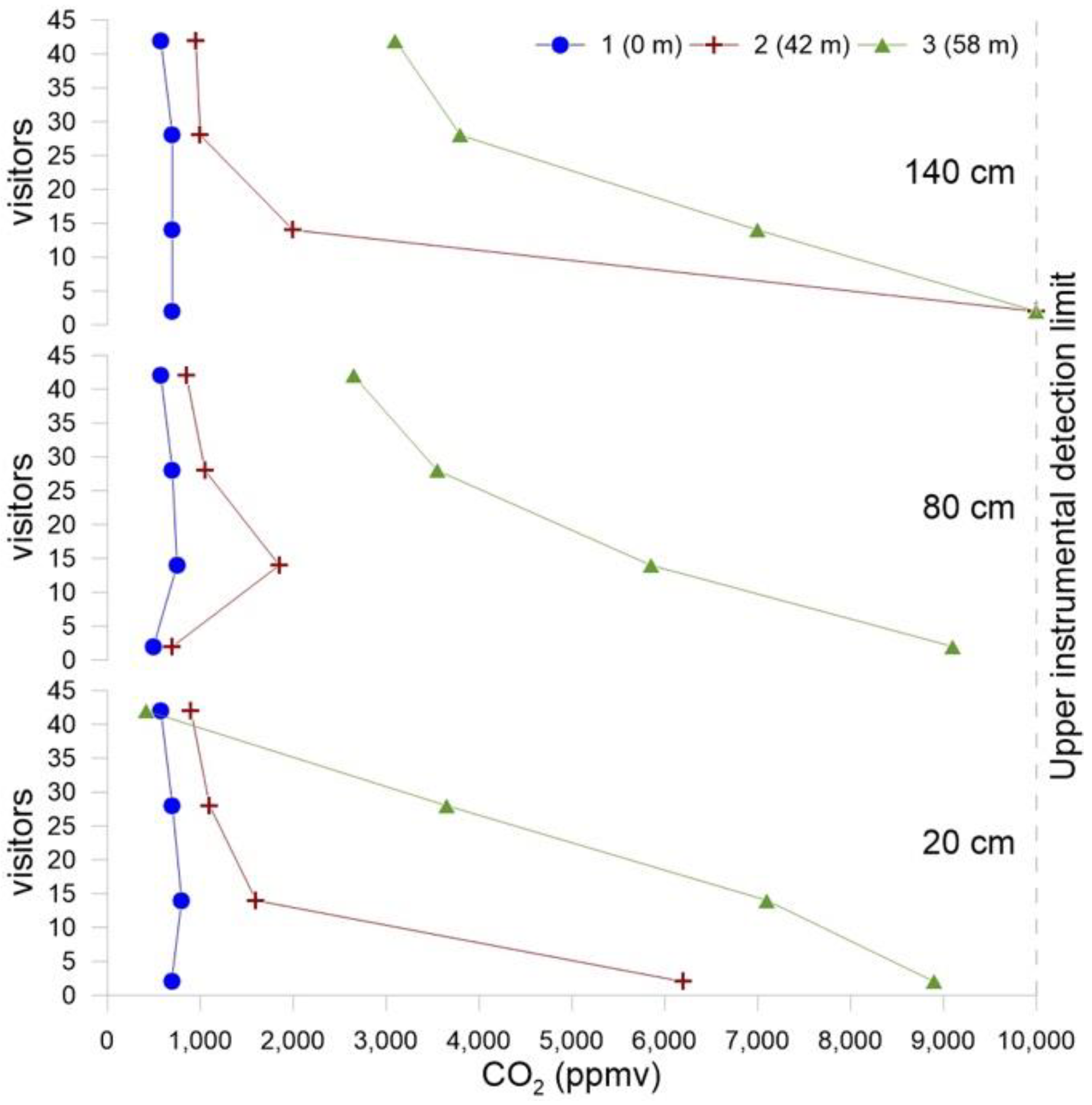
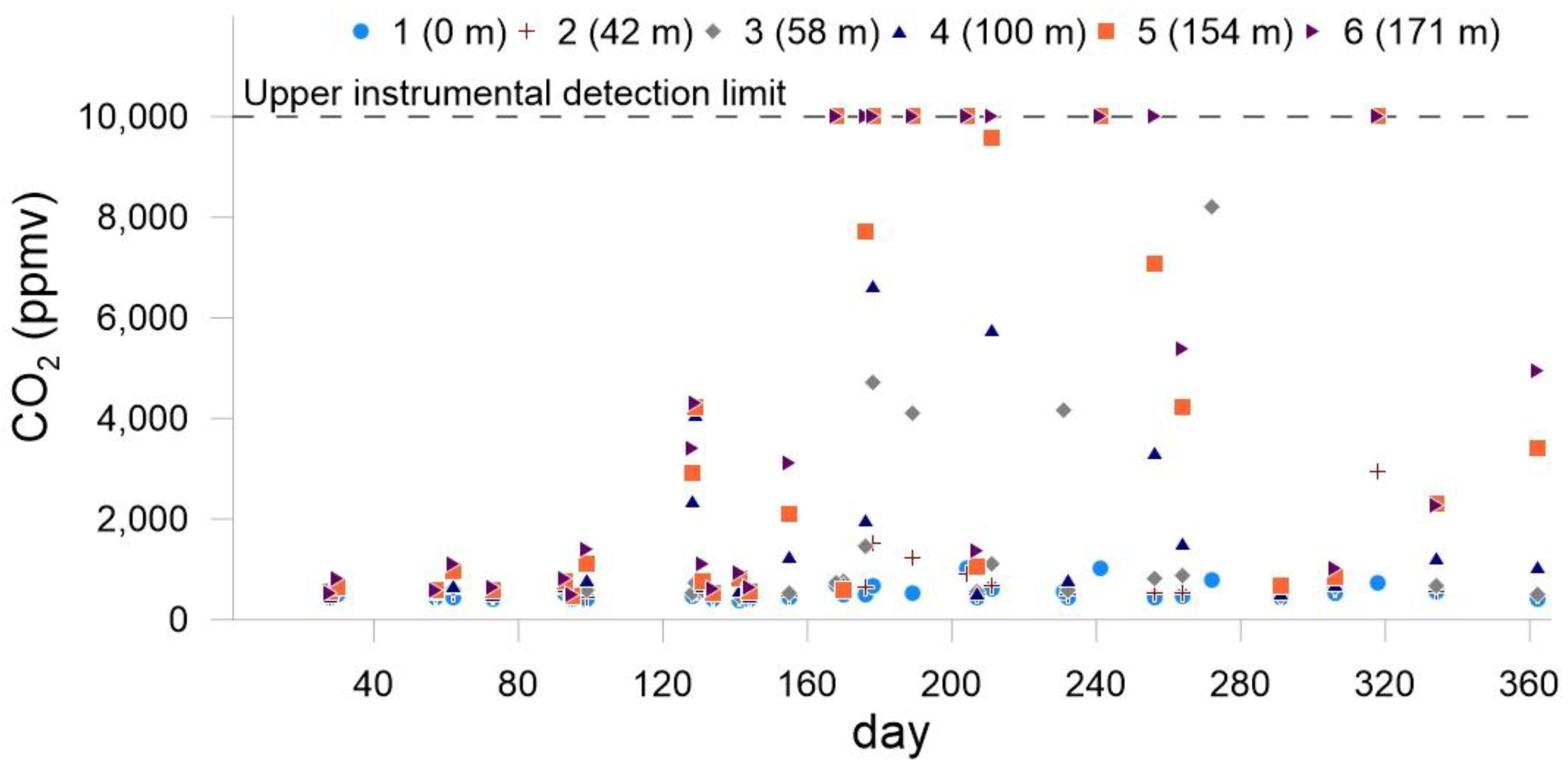
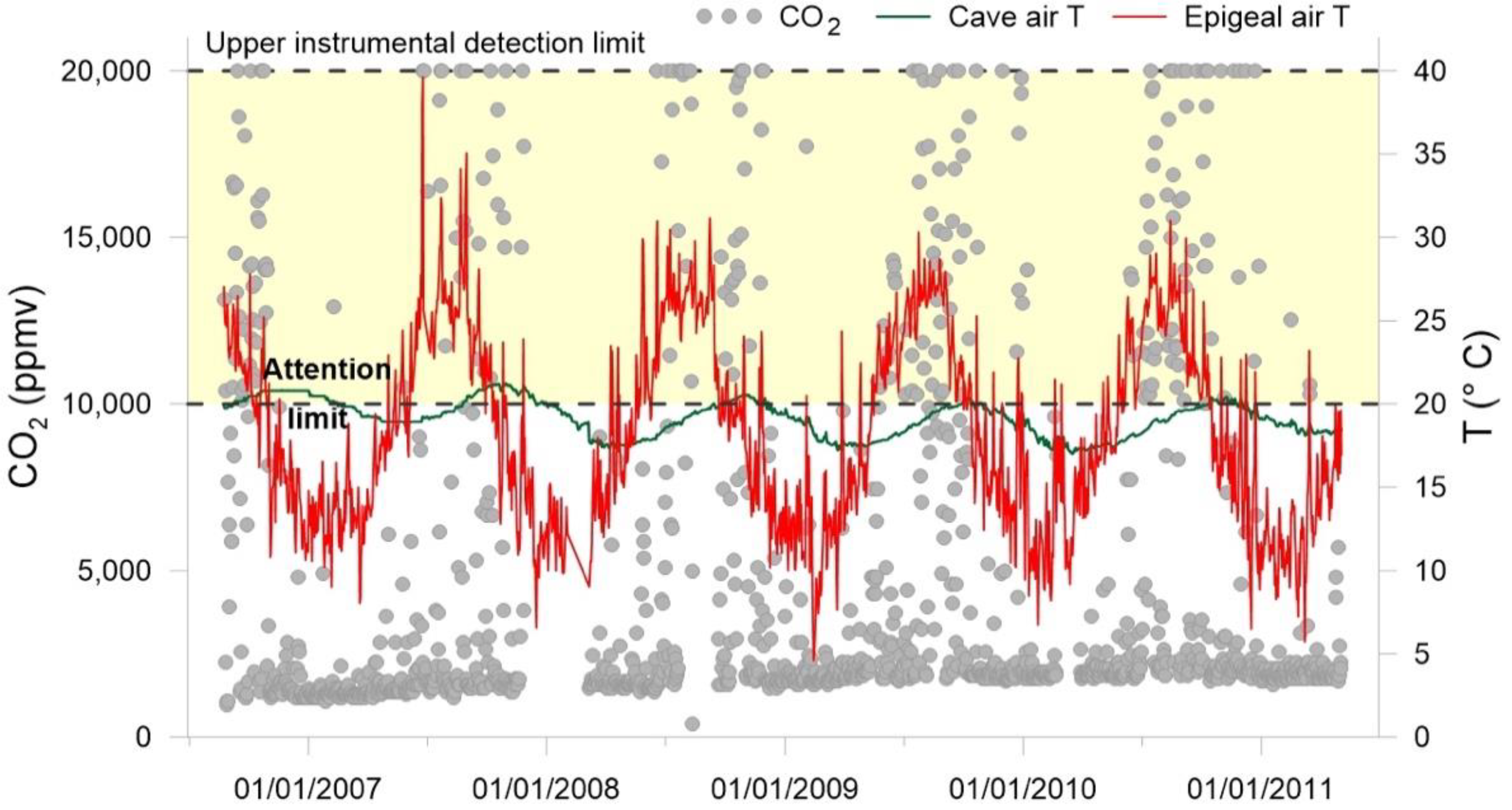
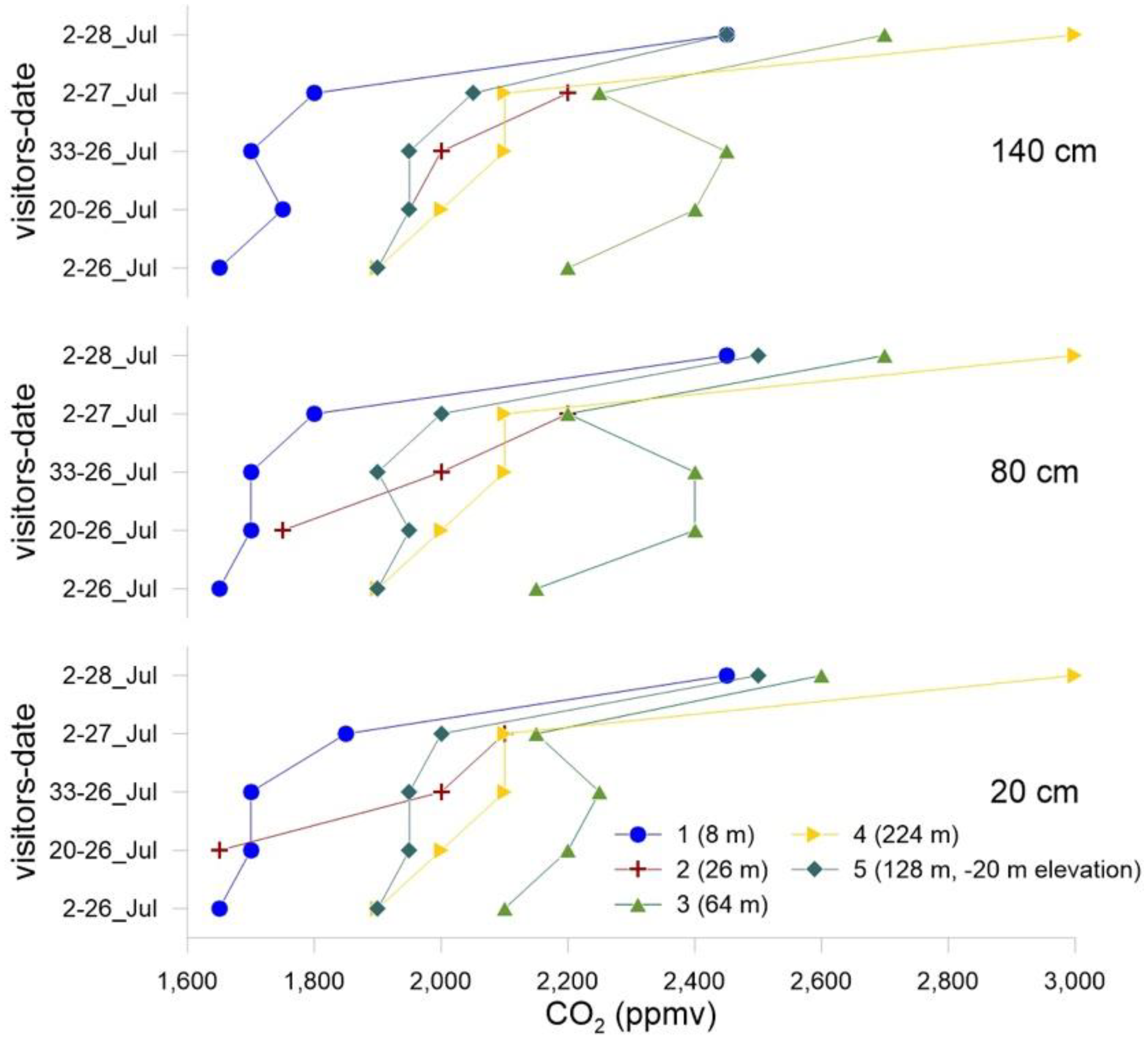
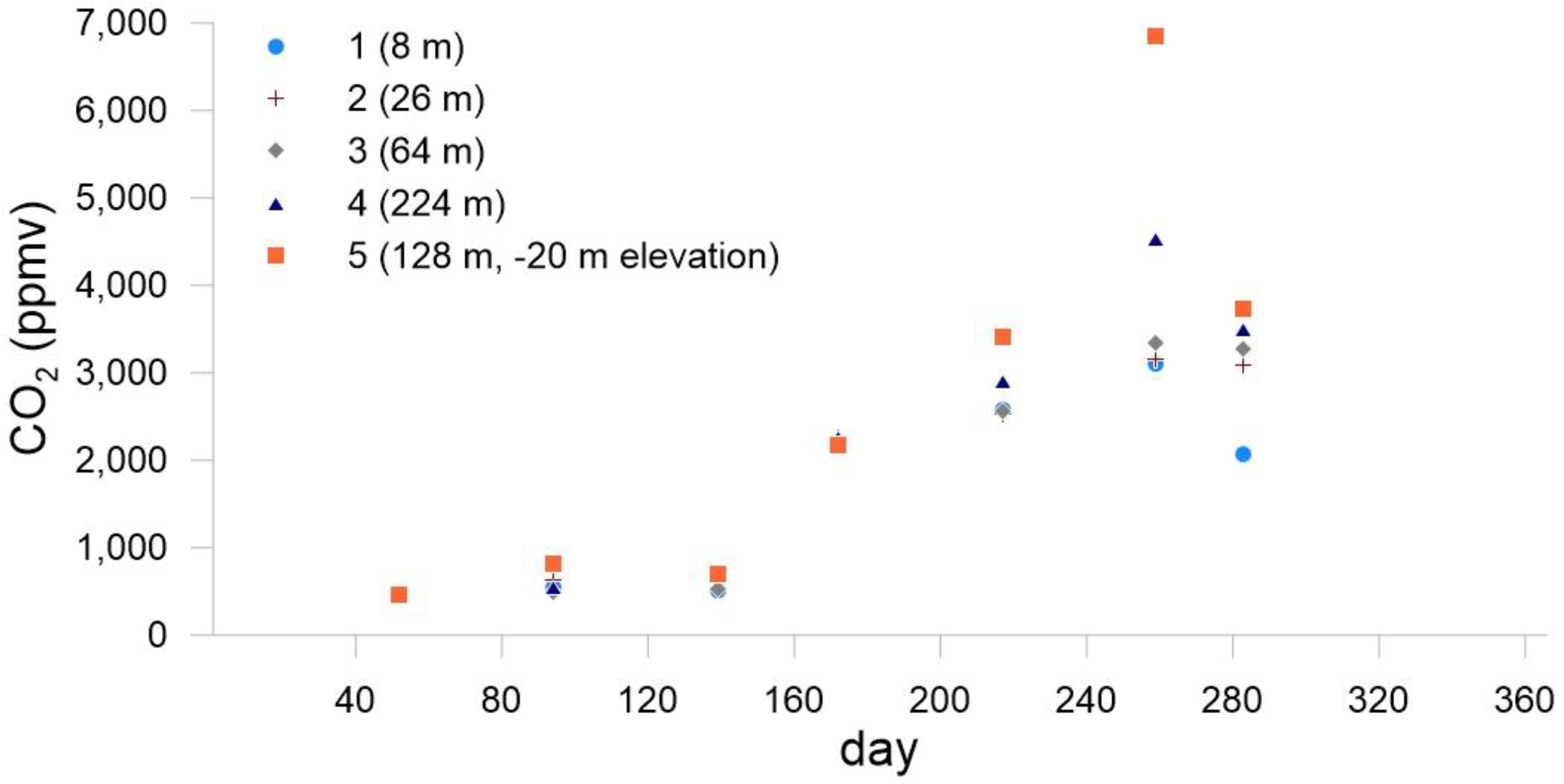
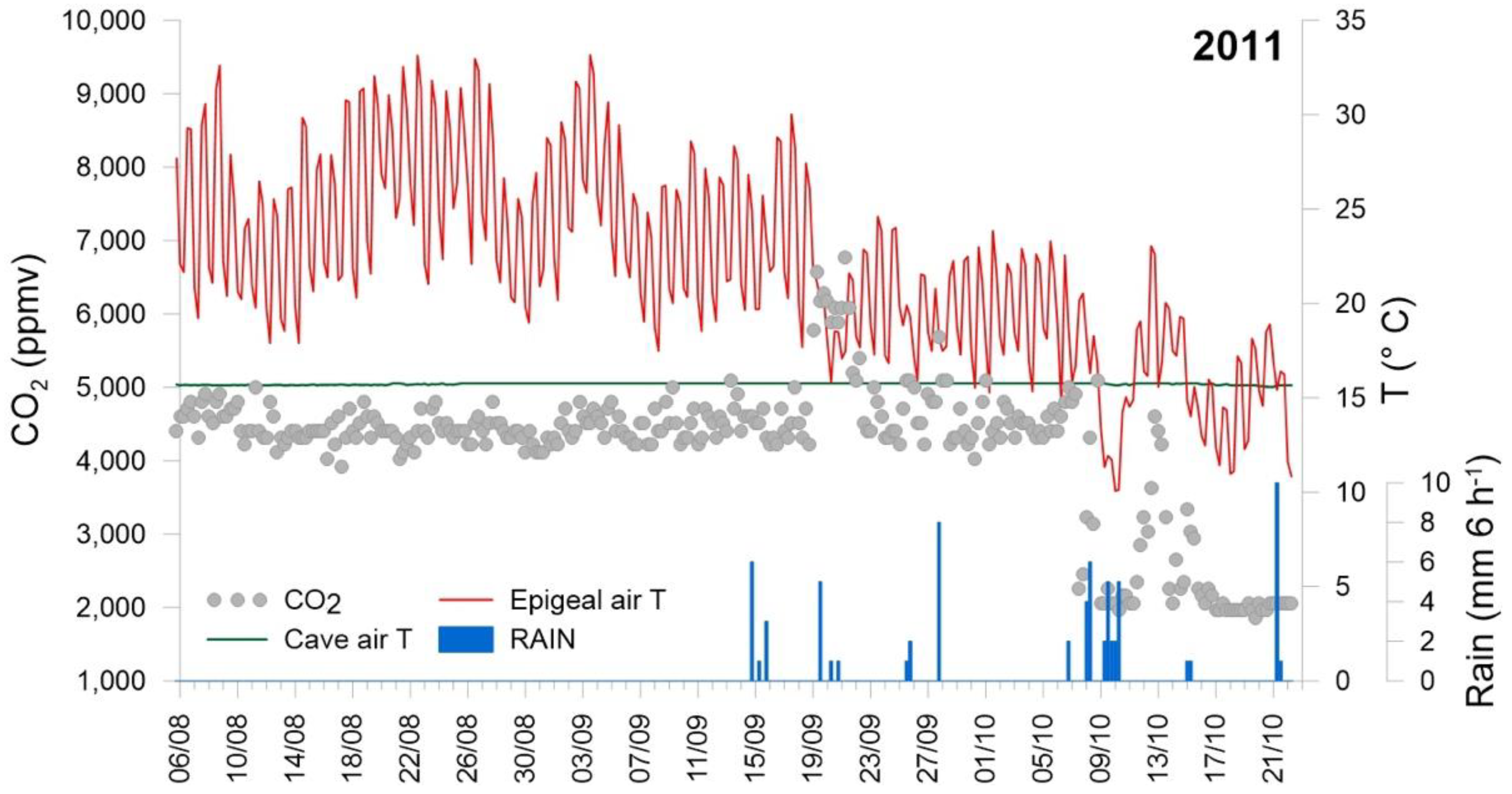
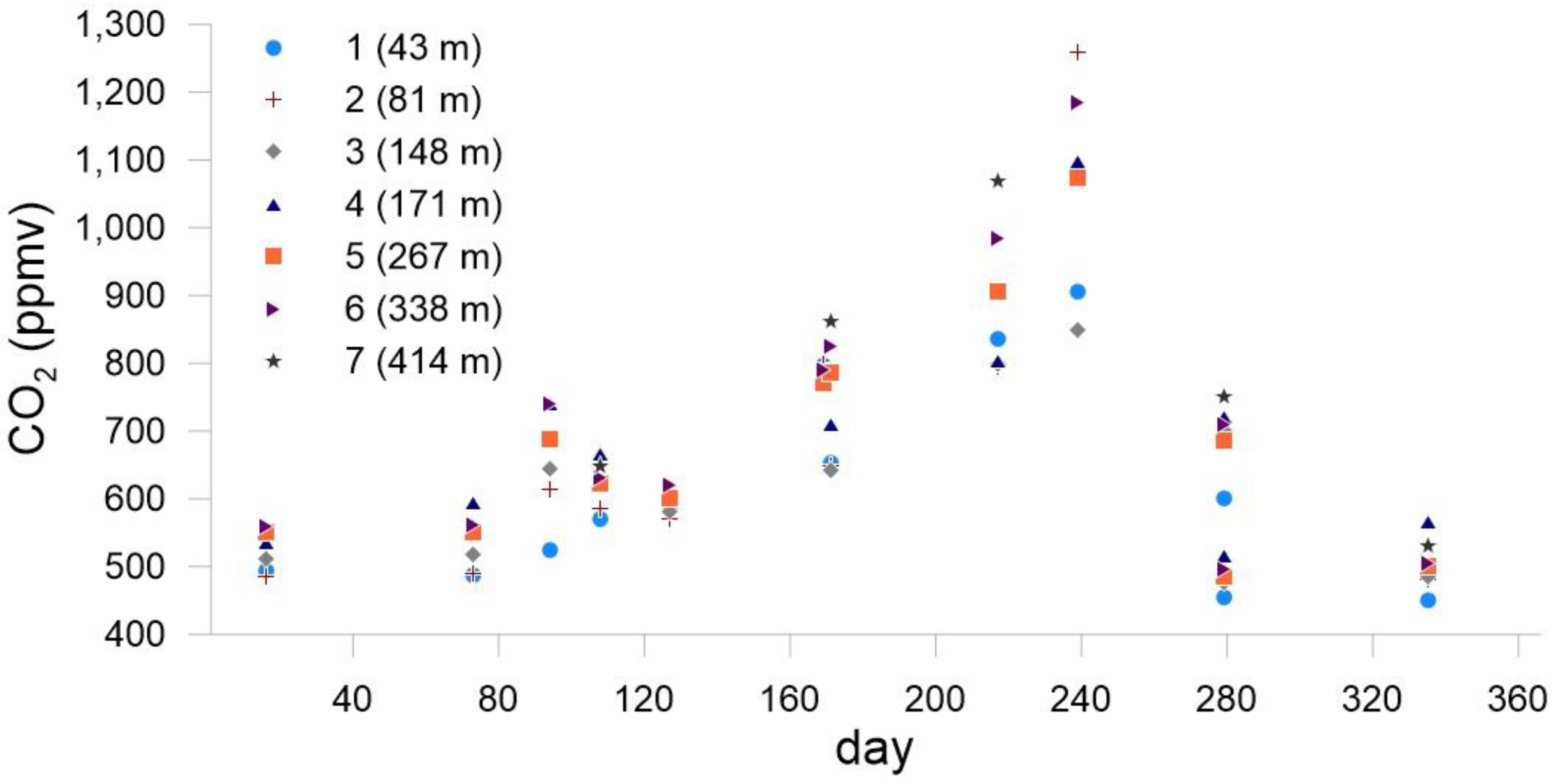
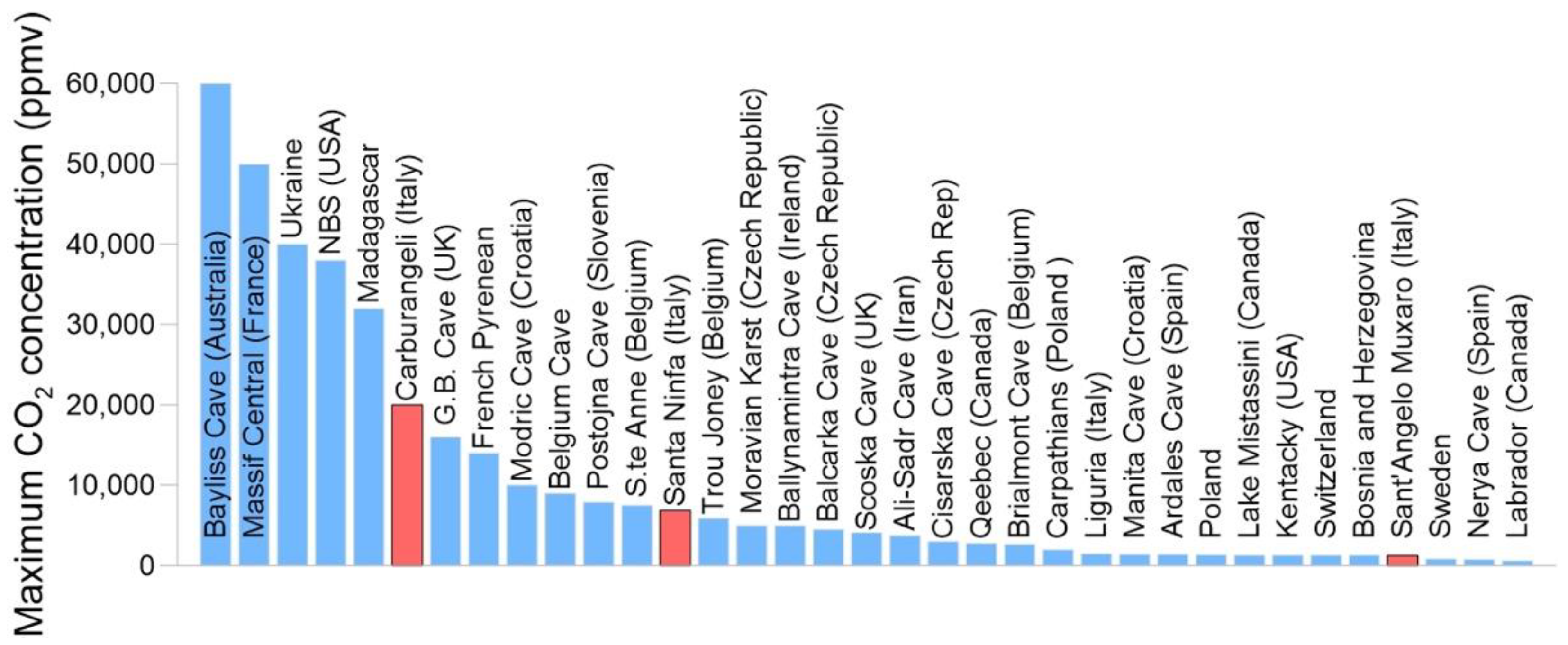
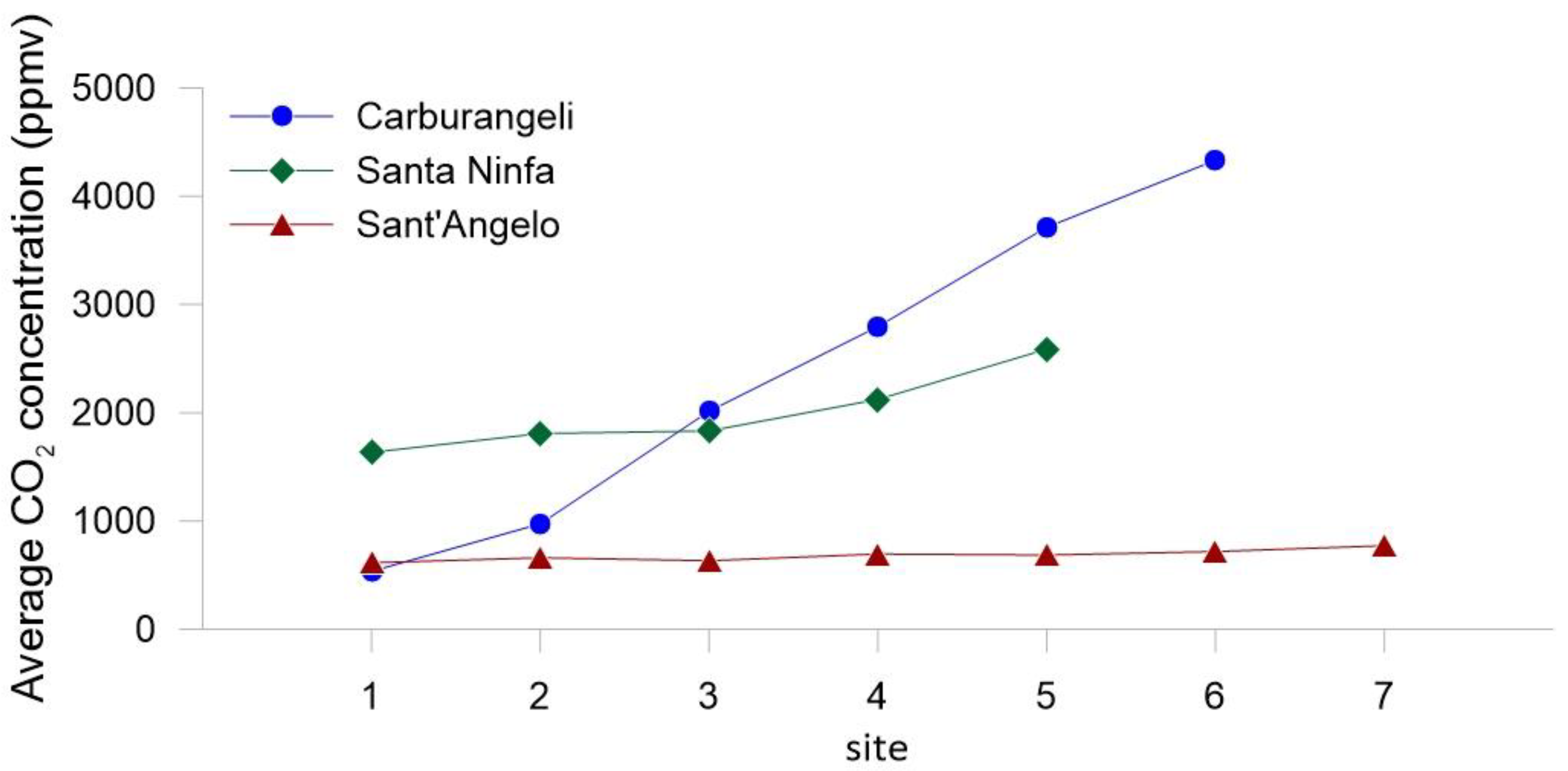
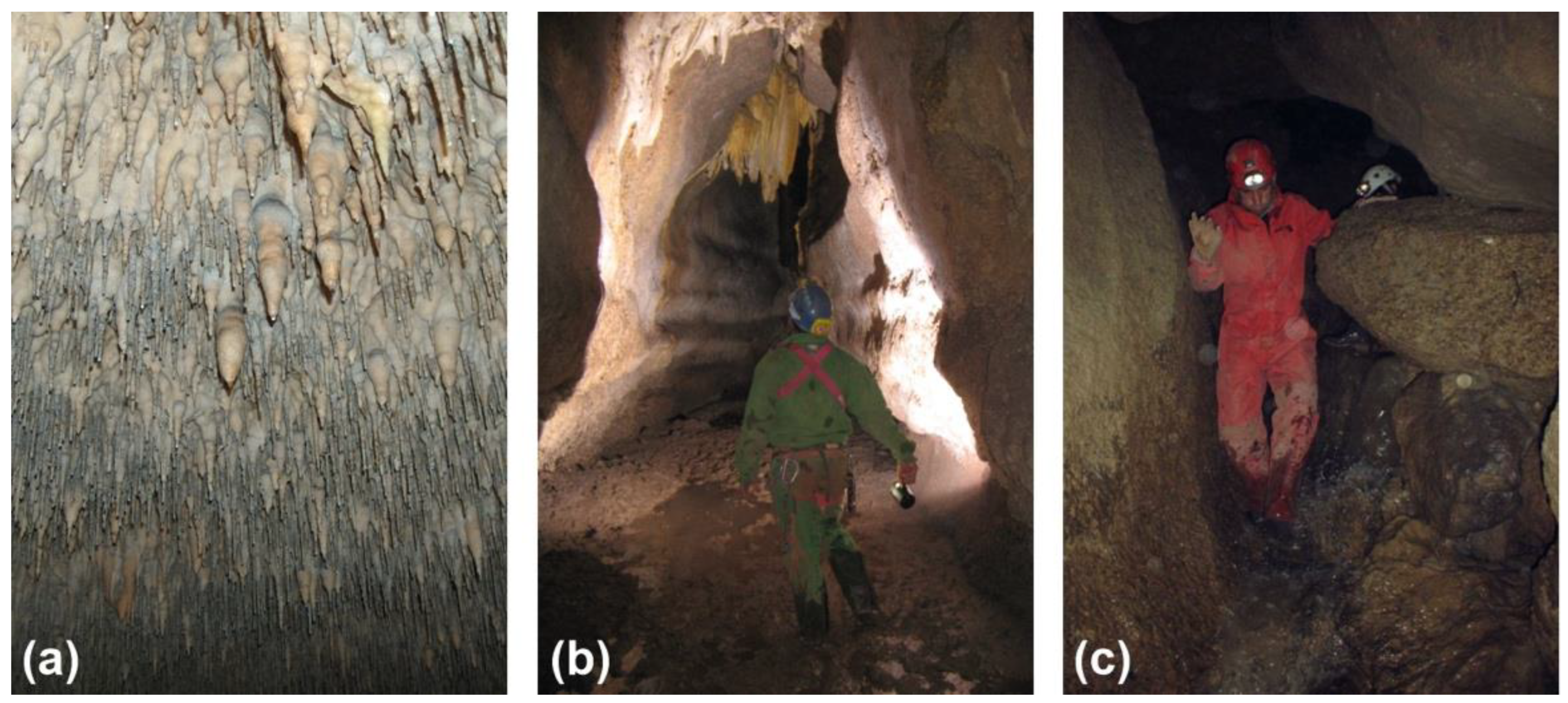
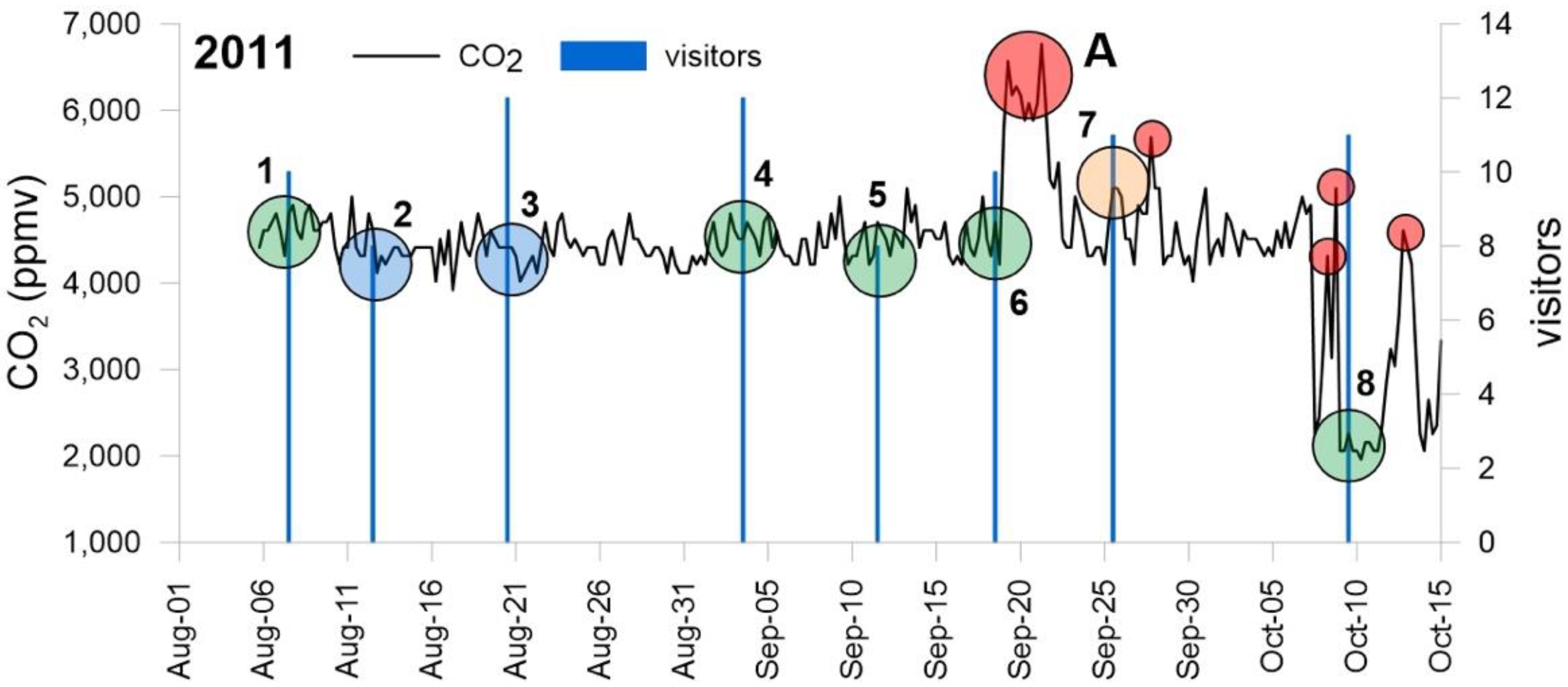

| Cave | Data | Year | Source |
|---|---|---|---|
| CAR | T, CO2 (spot) | 2000 | [15] |
| CAR | T, CO2 (spot) | 2002–2003 | This work |
| CAR | T, CO2 (spot and NRT) | 2006–2007 | [15] |
| CAR | T, CO2 (NRT) | 2007–2011 | This work |
| SAM | T, CO2 (spot) | 2005–2007 | This work |
| SNI | T, CO2 (spot) | 2000 | [19] HC |
| SNI | T, CO2 (spot) | 2004–2007 | This work |
| SNI | T, CO2 (NRT) | 2011 | This work |
| Level | CO2 Concentration | Mitigation Actions |
|---|---|---|
| 1. Attention | 1% | Limit to 2–3 h visiting times; Avoid numerous visitor groups; Pay attention to symptoms of physiological sufferance and, in case, immediately exit the cave |
| 2. Alert. | 2% | Access to specialized personnel only (cavers, scientists, workers); Limit to 1 h visiting times; Small groups (maximum 4–5 persons); Pay attention to early symptoms of physiological sufferance and, in case, immediately exit the cave |
| 3. Alarm | 3% | Access to specialized personnel only (cavers, scientists, workers); No access without wearing Individual Protection Devices (breathing apparatus); Visiting time controlled by breathing apparatus autonomy; Very small groups (3 persons); Pay attention to very early and light symptoms of physiological sufferance and, in case, immediately exit the cave |
Publisher’s Note: MDPI stays neutral with regard to jurisdictional claims in published maps and institutional affiliations. |
© 2022 by the authors. Licensee MDPI, Basel, Switzerland. This article is an open access article distributed under the terms and conditions of the Creative Commons Attribution (CC BY) license (https://creativecommons.org/licenses/by/4.0/).
Share and Cite
Madonia, P.; Cangemi, M.; Casamento, G.; Di Maggio, C.; Di Pietro, R.; Interlandi, M.; Barraco, G.; D’Aleo, R.; Di Trapani, F. Atmospheric CO2 Concentrations in Caves Protected as Nature Reserves and Related Gas Hazard. Atmosphere 2022, 13, 1760. https://doi.org/10.3390/atmos13111760
Madonia P, Cangemi M, Casamento G, Di Maggio C, Di Pietro R, Interlandi M, Barraco G, D’Aleo R, Di Trapani F. Atmospheric CO2 Concentrations in Caves Protected as Nature Reserves and Related Gas Hazard. Atmosphere. 2022; 13(11):1760. https://doi.org/10.3390/atmos13111760
Chicago/Turabian StyleMadonia, Paolo, Marianna Cangemi, Giulia Casamento, Cipriano Di Maggio, Rosario Di Pietro, Marco Interlandi, Gianfranco Barraco, Roberto D’Aleo, and Francesco Di Trapani. 2022. "Atmospheric CO2 Concentrations in Caves Protected as Nature Reserves and Related Gas Hazard" Atmosphere 13, no. 11: 1760. https://doi.org/10.3390/atmos13111760
APA StyleMadonia, P., Cangemi, M., Casamento, G., Di Maggio, C., Di Pietro, R., Interlandi, M., Barraco, G., D’Aleo, R., & Di Trapani, F. (2022). Atmospheric CO2 Concentrations in Caves Protected as Nature Reserves and Related Gas Hazard. Atmosphere, 13(11), 1760. https://doi.org/10.3390/atmos13111760






